
| ||
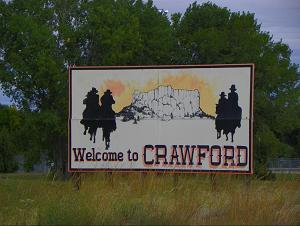
|
Crawford, NE | Also known as the "Big Game Capital of Nebraska", this area is a destination point of both nature lovers and game hunters alike. The Pine Ridge area is full of trails for hiking, biking and horseback riding. Several lakes, streams and rivers provide boating, fishing, camping and photo opportunities. The area is also rich in Fossils with two world-class bone beds. Rock collectors visit the area seeking Fairburn and Nebraska Blue Agate. Crawford is located in the scenic Pine Ridge area of Nortwest Nebraska, just three miles east of historical Fort Robinson State Park and 50 miles south of South Dakota's Black Hills. Established in 1886 as the Fremont Elkhorn Railroad pushed west. U.S. Highway 20 and State Highway 71-2 intersect at Crawford. Whether in Crawford for business, recreation or raising a family, Crawford truly is a garden of opportunity. |
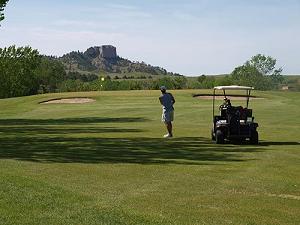
|
Legend Butte Golf Course | The 9-hole "Legend Butte" course at the Legend Butte Golf Course facility in Crawford, Nebraska features 3,178 yards of golf from the longest tees for a par of 36 . The course rating is 35.2 and it has a slope rating of 125. Designed by Mr. Weiss, the Legend Butte golf course opened in 1992. Crystal Jones manages the course as the General Manager. |
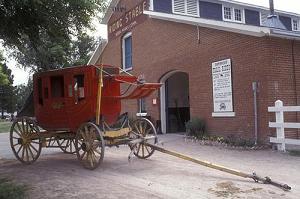
|
Fort Robinson State Park | The Crawford area is not only surrounded by exquisite Pine Ridge scenery but filled with compelling old west history. Fort Robinson, 3 miles west of Crawford, is famous for the Cheyenne Outbreak which took place in 1879, the death of famed Sioux Chief Crazy Horse, Red Cloud Indian Agency, Cavalry Remount Station, K-9 Dog Training Center, POW Camp and a Beef Research Station. In 1885, black soldiers of the ninth and tenth cavalry regiments (called �buffalo soldiers� by the Plains Indians) arrived at Fort Robinson. The �buffalo soldiers� garrisoned Fort Robinson for eighteen years and played an important role in northwestern Nebraska�s history. |
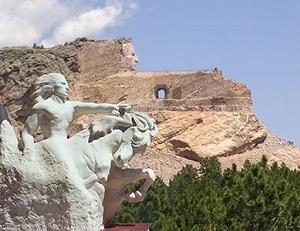
|
Crazy Horse Monument | Crazy Horse united with Chief Sitting Bull on the banks of the Little Big Horn River, where he helped annihilate a battalion of U.S. soldiers under Lieutenant Colonel George A. Custer (June 25, 1876). Crazy Horse was pursued by Colonel Nelson A. Miles and finally surrendered to General Crook at the Red Cloud Agency May 6, 1877. He was confined to Fort Robinson where he was killed in a scuffle with soldiers who were trying to imprison him in a guard house. |
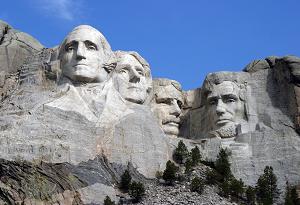
|
Mount Rushmore | Mount Rushmore National Memorial is a sculpture carved into the granite face of Mount Rushmore near Keystone, South Dakota, in the United States. Sculpted by Gutzon Borglum and later by his son Lincoln Borglum, Mount Rushmore features 60-foot sculptures of the heads of former United States presidents (in order from left to right) George Washington, Thomas Jefferson, Theodore Roosevelt and Abraham Lincoln. The entire memorial covers 1,278.45 acres and is 5,725 feet above sea level. |

|
Battle of Warbonnet Creek | The Battle of Warbonnet Creek was a skirmish characterized by a dual between �Buffalo Bill� Cody and Cheyenne Chief Yellow Hair (often incorrectly translated as �Yellow Hand�). The battle occurred on July 17, 1876 in Sioux County, Nebraska, not too far from Fort Robinson and Crawford. The Cheyenne were attempting to join the victors of the Battle of Little Big Horn when they were intercepted by Buffalo Bill and the 5th Cavalry. Cody pulled his Winchester carbine and killed Yellow Hair, then pulled out a Bowie knife and scalped him. The battle is often referred to as the �First Scalp for Custer� because of this incident. A stone monument marks the location of that fatal confrontation between Cody and Yellow Hair. |
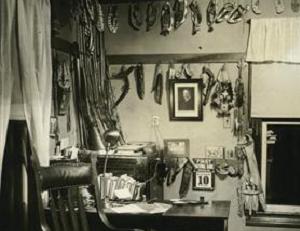
|
James Cook Collection |
James Cook, who owned the Agate Springs Ranch on the Niobrara River, chanced to meet Red Cloud of the Oglala Lakota Sioux while at the Red Cloud Agency near Fort Robinson. They became lifelong friends. Red Cloud and his people would travel 150 miles by horse and wagon from the Pine Ridge Reservation in South Dakota to Cook�s ranch (southwest of Crawford) for a visit. They needed a pass to leave the reservation and needed the pass to return to it. This was more than a �visit�, they seemed to revert back to a time when their lives were spent hunting, following game, harvesting native plants and trading with other people. During these visits, the Lakota and Northern Cheyenne gave gifts to James Cook and his family and received beef and hides in return. Some of the gifts were made especially for the Cooks including buckskin suits and gloves. Other items were very special, such as a shirt which had belonged to Red Cloud, three generations |
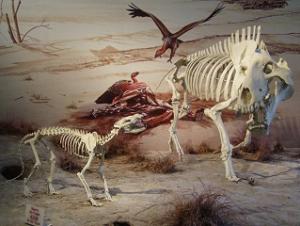
|
Agate Fossil Beds |
of pipebags (one belonging to Red Cloud, his father and his son) and one of Crazy Horse�s whetstones. James Cook and his descendents concluded that these gifts should remain in the immediate area of the ranch. Consequently, one of the most pleasant surprises for many visitors of Agate Fossil Beds National Monument is the Cook Collection of Native American artifacts! The Crawford area is a wonderful place to learn about paleontology and hunt for fossils. During the 1890�s, scientists rediscovered what the Lakota Sioux already knew � bones preserved in one of the most complete Miocene mammal sites in the world. Agate Fossil Beds National Monument visitor center was constructed in early 1990s and is located just southwest of Crawford. |
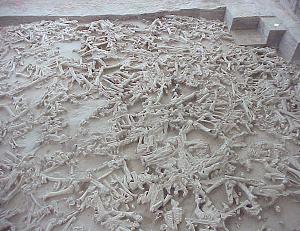
|
Hudson Meng Bison Kill | About 10,000 years ago, over 600 bison died in an arroyo located in the Oglala National Grassland 19 miles north of Crawford. In 1997, a climate controlled enclosure was completed over the central portion of the bonebed. A visit to the Hudson-Meng Education and Research Center will allow you to view a contemporary archeological excavation in progress! |
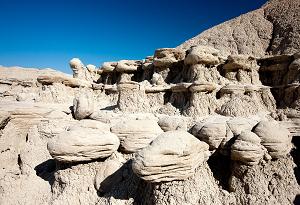
|
Toadstool Geologic Park | Not too far from the Hudson-Meng is Toadstool Park noted for unusual geologic formations and scientifically valuable fossil deposits. One can enjoy a 1-mile loop walking trail around the unique eroded clay/sandstone formations. |
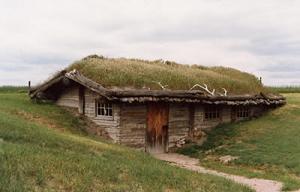
|
Museum of the Fur Trade | The Museum of the Fur Trade combines an outstanding collection and scholarship to interpret the story of the fur trade. The non-profit museum exhibits discuss the fur trade from early colonial days to the present century. The exhibits trace typical Plains and Woodland Indians. Exhibits include the entire range of trade goods, including munitions, cutlery, axes, firearms, textiles, costumes, paints and beads. The museum stands on the site of James Bordeaux trading post established for the American Fur Company in 1837. |
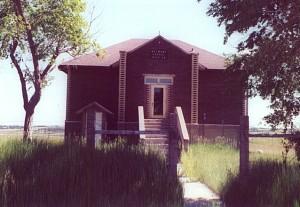
|
Nebraska Ghost Towns | Many of the first settlements in the Crawford area were along rivers, creeks, the stage route and eventually the railroad. Many of these settlements grew to a fair size before the decline of their inhabitants. Glen, Andrews, Montrose, Orella, Marsland and Belmont are all �Ghost Towns� that are within close proximity of Crawford. Each has a unique and interesting story and is great place to explore! |
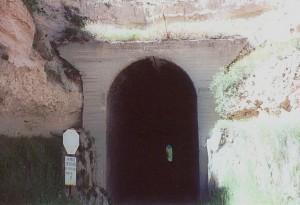
|
Belmont Railroad Tunnel | In 1888, Burlington railway crews reached Dawes County and established depots along the proposed line wherever they were needed. A camp was established at the crest of a large hill through which the �Belmont Tunnel� was to be dug. The Belmont Tunnel is Nebraska�s only railroad tunnel! Belmont which is 12 miles south of Crawford was a railway stop for passenger trains on the way to the Black Hills in South Dakota. Local ranchers in the area took cans of cream to the depot in Belmont to send them to the creamery in Alliance to sell. |
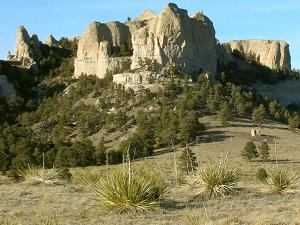
|
Crow Butte | Crawford is surrounded by the Pine Ridge and beautiful buttes. Crow Butte is located a few miles southeast of Crawford. Legend has it that long ago (1849) a band of Crow Indians returning from a hunting trip were surrounded by Sioux Indians. The Crow were forced to take refuge on the butte which was accessible by only one side. The Sioux decided to guard the one pass through the night and pursue the Crow the next morning. The Crow worked diligently through the night to make ropes out of their blankets and whatever else they had. They used them to descend over the cliffs of the butte. They were able to surround the Sioux and as the story goes the Crow took many Sioux scalps! |
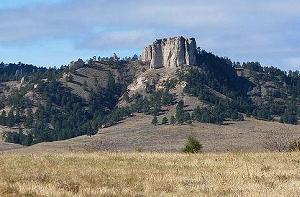
|
Lovers Leap Butte | Lovers Leap is a picturesque butte located a short distance west of Crawford. The legend behind its name indicates the Native American�s sense of romance was strongly developed regardless of their apparent stoicism! A young Indian maiden was in love with a brave in her own tribe. But her father arranged for her to marry a brave of another tribe in exchange for the brave�s finest ponies. The maiden and her lover tried to run away, but her father had him killed. The maiden sang the Death Song as she walked to the top of Lovers Leap and, with a cry to her dead lover, she leaped over the cliff! |

|
Chimney Rock | Chimney Rock is a famous, prominent geological rock formation in Morrill County in western Nebraska. Rising nearly 300 feet above the surrounding North Platte River valley, the peak of Chimney Rock is 4,226 feet above sea level. During the middle 19th century it served as a landmark along the Oregon Trail, the California Trail, and the Mormon Trail, which ran along the north side of the rock. It is visible for many miles from the east along U.S. Route 26. |
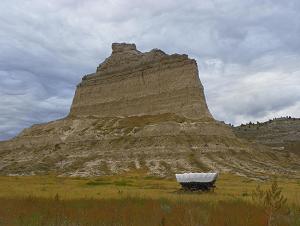
|
Scotts Bluff National Monument | Scotts Bluff National Monument towering eight hundred feet above the North Platte River, Scotts Bluff has been a natural landmark for many peoples, and it served as the path marker for those on the Oregon, California, Mormon, and Pony Express Trails. Scotts Bluff National Monument preserves 3,000 acres of unusual land formations which rise over the otherwise flat prairieland below. Visitors can hike the Saddle Rock Trail, drive to the summit, visit the Oregon Trail Museum and Visitor Center, and even relive life on the Oregon Trail during our special Living History program on weekends during the summer. |
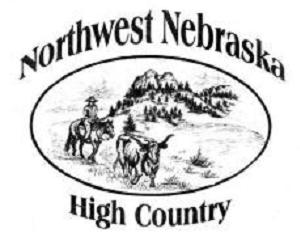
|
Northwest Nebraska High Country | The Crawford area is definitely a place to visit and enjoy the scenery and the history. The Northwest Nebraska High Country is an organization of more than twenty ranchers and farmers who are offering their private property for tourism, hunting, bed and breakfasts, guest and working ranch getaways, horseback adventures, farmer�s market, wildlife viewing, bird watching, stargazing and much more! They are willing to share their �Country Way of Life� with willing participants and are willing to bend over backwards to make them feel welcome and at home! |
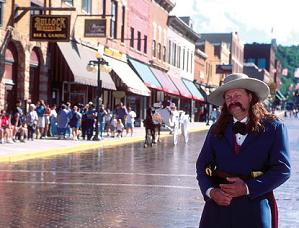
|
Deadwood, SD | Historic Deadwood, in the Black Hills of South Dakota, is an old mining town that�s still as wild at heart as it was in the 1800s when the outlaws, gamblers and gunslingers ruled the streets. Today, the entire Black Hills� town is a National Historic Landmark and an ideal place to release your inner outlaw. Walk in the footsteps of legends�like Wild Bill Hickok, Calamity Jane and Seth Bullock�as you discover Deadwood�s Wild West ways. Deadwood�s 80 historic gaming halls are full of the latest slot machines, Blackjack, poker and Texas Hold�em tables. |
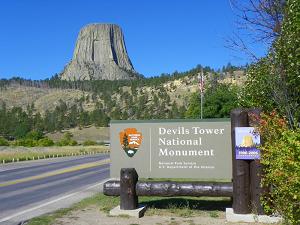
|
Devils Tower National Monument | Devils Tower is a monolithic igneous intrusion or volcanic neck located in the Black Hills near Hulett and Sundance in Crook County, northeastern Wyoming, above the Belle Fourche River. It rises dramatically 1,267 feet above the surrounding terrain and the summit is 5,112 feet above sea level. Devils Tower was the first declared United States National Monument, established on September 24, 1906, by President Theodore Roosevelt. The Monument's boundary encloses an area of 1,347 acres. In recent years about 1% of the Monument's 400,000 annual visitors climb Devils Tower, mostly through traditional climbing techniques. |